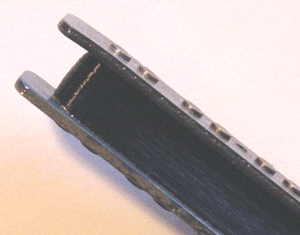A cool looking Fender Jazz bass came into my shop one day for a little service. There was no signal coming from the neck pickup, so I used my ohmmeter to check the DC resistance of each pickup. The bridge pickup metered 6.8k DC resistance, but the neck pickup read as an open. I checked the solder joints to make sure that there was no oxidation, then thought there might be a break in the coil wire. Maybe the lacquer that was used in the dipping process at Fender caused the enamel coating around the wire to fail (lacquer gasses will eat away at the enamel coating over time). I used Gruhn’s Guide to Vintage Guitars to determine this Fender Jazz bass was manufactured in 1971.
My first choice was to unwind the coil up to the break or corrosion and repair it. Inspecting the pickup, it was clear that this wasn’t going to be an option, as the finished pickup was dipped in lacquer and the coil was not going to separate very easily. You can see that the light gray bobbin flat work, vulcanized fiber, was warped on the ends, even thought it had a protective seal coat of lacquer. The pickup was wound with 42 Plain Enamel (42 gauge wire with enamel insulation). Fender used this and Formvar copper wire in their pickups during the vintage era, and continue to use it today. Fender also uses 43 Plain Enamel for their Tele neck pickup.
Important tools for restoring pickups, available at stewmac.com:
#1465 - Schatten Pickup Winder
#5127 – Schatten Magnetic Polarity Tester
#1462 – Pickup Coil Wire 42 gauge “poly-coated”
#3593 – Digital Multimeter
#0668 – Glue pot for wax potting pickups
#4643 – Neodymium Boride magnets for recharging dead or weak magnets
|
I wanted to get a better knowledge of how many windings there were to this ’71 bass neck pickup. The Schatten Pickup Winder was not only going to be used for rewinding the pickup, but also to unwind the original coil. It’s very important to make notes on which direction the coil wraps to the lead wires so that there are no phasing issues later on. I attached the pickup with double stick tape to the left winder arm and slowly removed the pickup winds using my custom-built, foot-operated speed control. The pedal is a broken down Wah Wah that Casey Gooby modded for me to use with the winder. There were several breaks in the coil along the way because of the stiff lacquer coating, but I managed to get what I felt to be an accurate reading of the number of turns by the built in counter: 8,000 turns plus. Once the coil wire was removed, I saw that the magnets were wrapped in 1/2” masking tape. Years back on older Fender pickups, when the windings were in direct contact with the magnets, there was a chemical reaction to the insulation causing the windings to fail. Today after the magnets are installed in the flatwork, before winding the coil, it is dipped into a pail of lacquer or the lacquer is sprayed over the magnet and flatwork. This coating will keep the inner windings from direct contact with the magnets.
Rewinding with 42 Plain Enamel
I lightly scrubbed the pickup with a soft bristle brush to remove any loose particles before rewinding and attached it to the right winding arm. Start about eight wraps by hand, and adjust the traverse end-stops so that the wire will flow inside the inner faces of the flats. Set the counter to zero, and start the winder slowly. Increasing the speed gradually, I use my fingers to grip and guide the wire along the traverse. On my way to 8,000 turns I use my foot control, slowing down the arm occasionally to check the winds and make sure everything is laying right. If it’s too tight, you can deform the bobbin; too loose and your pickup will be microphonic. The secret is in the feel of the wire when hand winding.
Once I have the amount of turns I’m looking for, I use an X-Acto knife to gently scrape off a section of protective enamel and meter the DC resistance before cutting off the line from the spool. The neck pickup reads 6.55k DC resistance, which will compliment the bridge pickup’s 6.8k. My magnetometer reads the strong Alnico 5 magnets at 50 gauss with a north magnetic pull. This will insure the output signal is strong and steady, as the pickup was originally intended to be.
I really get a natural high out of winding pickups… it’s the feel of the wire racing through my fingers, the whispering sounds as the bobbin spins, and directing the wire to give the pickup its natural voice. To finally hear that voice is kind of like magic!
John Brown
John Brown, of Brown's Guitar Factory, is the inventor of the Fretted/Less bass. He owns and operates a full guitar manufacturing and repair/restoration facility, which is staffed by a team of talented luthiers. He is also the designer of guitar making/repair tools and accessories that are used today by instrument builders throughout the world.
brownsguitarfactory.com
info@brownsguitarfactory.com







![Rig Rundown: AFI [2025]](https://www.premierguitar.com/media-library/youtube.jpg?id=62064741&width=1245&height=700&quality=70&coordinates=0%2C0%2C0%2C0)












 Shop Scott's Rig
Shop Scott's Rig















































